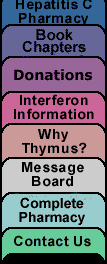Hi Lloyd,
I have been following your plan for over a year with good
results. I had substituted sugar with splenda thinking
that would be a wiser choice being that sugar can slow your
immune system down. Boy was I wrong! I will be
throwing it all out after I send this e-mail.
Check it out, I think this is important info for those who
have Hep c and especially for those on your treatment plan.
God Bless
A. F.
Vero Beach, FL
Splenda, also known as sucralose, is artificial sweetener
which is a
chlorinated sucrose derivative. Facts about this artificial
chemical
follows:
Pre-Approval Research
Pre-approval research showed that sucralose caused shrunken
thymus glands (up to 40% shrinkage) and enlarged liver and
kidneys. The manufacturer put forth two arguments in
an attempt to claim that sucralose is not toxic:
The dose of sucralose in the experiments was high. However,
for chemicals
that do not have generations of safe use, the dosage tested
must be adjusted for variations in potential toxicity within
the human population and between humans and rodents.
In order to this, toxicologists estimate a variation of effects
in the human population of 10 times. In other words,
one person may not have effects until a dose of 10 mg per
kg of body weight (10 mg/kg) is reached, while another person
may have chronic toxicity effects at 1 mg per kg of body weight
(1 mg/kg). In addition, it is well known that many chemicals
are much more toxic in humans than in rodents (or even monkeys).
For example, the chemicals that the sweetener aspartame
breaks down into vary from 5 to 50 times more toxic in humans
than in rodents. Therefore, toxicologists estimate a
further 10 times the dose for differences between human and
rodent toxicity for a total of 100 times (10 * 10).
In order to estimate a potential safe dose in humans, one
must divide the
lowest dose in given to rodents that was seen to have any
negative effects on their thymus glands, liver or kidneys
by 100. That dose is then known as the maximum Tolerable
Daily Intake (TDI) for lifetime use. Keep in mind that
the TDI is just an estimate. Some chemicals are much
more than 10 times more toxic in humans than in rodents (or
will cause cancer in humans in low-dose, long-term exposure
and do not cause cancer in rodents at all). A person
ingesting the TDI for some chemical may find that it causes
cancer or immune system or neurological problems after many
years or decades of use. So, if the manufacturer claims
that the dose was equivalent to 50 diet sodas, then the TDI
would be one half (1/2) of a diet soda, and even that dose
may or may not be safe.
The manufacturer claimed that the sucralose was unpleasant
for the rodents to eat in large doses. They said that
starvation caused the shrunken thymus glands. From
the New Scientist (23 Nov 1991, pg 13):
Toxicologist Judith Bellin reviewed studies on rats starved
under experimental conditions, and concluded that their growth
rate could be
reduced by as much as a third without the thymus losing a
significant amount of weight (less than 7 percent).
The changes were much more marked in rats fed on sucralose.
While the animals' growth rate was reduced by between
7 and 20 percent, their thymuses shrank by as much as 40 percent.
Recent Research
A possible problem with caecal enlargement and renal mineralization
has been seen in post approval animal research.
Sucralose Breaks Down
Despite the manufacturer's mis-statements, sucralose does
break down into small amounts of 1,6-dichlorofructose, a chemical
which has not been
adequately tested in humans.
Independent, Long-Term Human Research
None. Manufacturer's "100's of studies" (some
of which show hazards) were clearly inadequate and do not
demonstrate safety in long-term use.
Chlorinated Pesticides
The manufacturer claims that the chlorine added to sucralose
is similar to
the chlorine atom in the salt (NaCl) molecule. That
is not the case.
Sucralose may be more like ingesting tiny amounts of chlorinated
pesticides, but we will never know without long-term, independent
human research.
|


